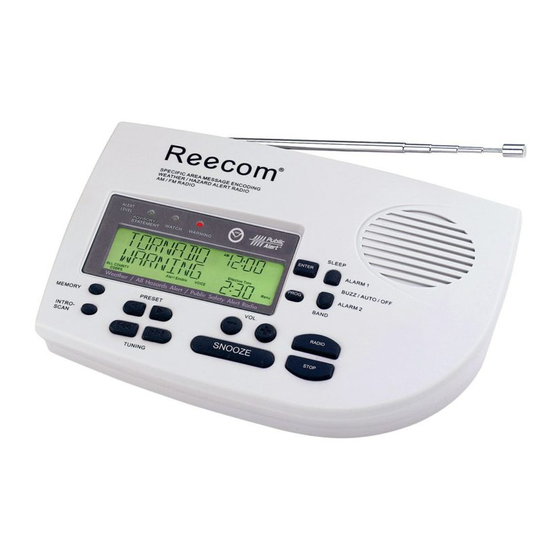
Advertisement
Up-to-the-Minute Weather Reports and Emergency
________________________________________
1. Batteries: Critical in the event of a power loss. Do not use rechargeable batteries!
2. AC Power Adapter: Plug the AC Power Adapter into a 120 Volt AC power outlet
(standard house/school current). Plug AC Power Adapter into DC jack on back of the
radio.
3. Antenna: Position telescoping antenna vertical and extend to its full length above the
radio. The antenna is located on the back of the radio. If reception is poor, try moving
the radio to another location in the room.
4. Volume Adjustment:
1) Press the "Radio" button. This radio has AM/FM and Weather channels, so press
the "Band" button until "WX" displays in the lower right corner of the
display.Press "WEATHER/SNOOZE," and "WEATHER" will appear on the
display.
2) Press the "+" or "-" arrow to select volume.
5. Setting Radio to Alarm For Hazards
1) Hold down the "PROG" button for 2 seconds (until it beeps).
2) Press the right arrow until you see menu page P4. If "Alert Enable" flashes on the
display and "VOICE" is displayed next to this, your radio is all set (Press "Enter"
twice and "PROG" once to exit the menus).
3) If "Alert Disable" flashes, press the right arrow and "ENTER" to select "Alert
Enable." If "SIREN" then flashes, press the right arrow and "ENTER" to select
"VOICE."
NOAA All-Hazards
Weather Radio
REECOM RADIO – MODEL R-1650
Information
NOAA's National Weather Service
Billings, Montana
Setting Up Your Receiver
Advertisement
Table of Contents

Summary of Contents for NOAA R-1650
- Page 1 NOAA All-Hazards Weather Radio REECOM RADIO – MODEL R-1650 Up-to-the-Minute Weather Reports and Emergency Information NOAA's National Weather Service Billings, Montana ________________________________________ Setting Up Your Receiver 1. Batteries: Critical in the event of a power loss. Do not use rechargeable batteries! 2.
- Page 2 Programming Your Receiver Tuning to Your Local Transmitter: 1) Hold down the “PROG” button for 2 seconds (until it beeps). 2) Press the right arrow until you see menu page P2 and press “ENTER.” 3) The radio will begin broadcasting. Press the left or right arrows until the desired channel and is displayed and you hear the broadcast of the transmitter.

Need help?
Do you have a question about the R-1650 and is the answer not in the manual?
Questions and answers